The STEMScience, Technology, Engineering, and Mathematics subjects have a reputation for being historically male-dominated. Chemistry is no exception; according to reports by C&ENChemical & Engineering News, the weekly magazine of the American Chemical Society, only 39% of the total U.S. chemistry doctoral degrees awarded in 2009 were received by women. Even more strikingly, women comprise only 17% of all chemistry faculty at U.S. universities.
I have been curious about a question that isn’t specifically addressed in C&EN’s reports: how do male and female students distribute across labs run by male and female professors? To address this question, I performed my own crude survey of gender distribution among chemistry faculty and students using the primary tool at my disposal (i.e., the internet). I am in no way a statistician, so the following results shouldn’t be taken as hard science.
Methods
Since I am a graduate student myself and have limited time on my hands, I restricted my “study” to organic faculty at the top 10Harvard, Berkeley, Scripps, Stanford, MIT, Caltech, Illinois, Columbia, Wisconsin, Penn graduate schools for organic chemistry as ranked by U.S. News for 2010. From these schools’ chemistry department websites I obtained the following information: (1) The number of male and female faculty listed as being in an organic chemistry subdivision or having interests in organic chemistry, and (2) a head count of male and female graduate students, postdocs, or undergraduates in each professor’s lab (obtained from the group photo and/or the list of members on the group webpage).
There are, of course, several limitations to my research methods. For one, the sample size is small (only ten schools) and biased (the “top” ten), so demographics could be somewhat different than across the average of all U.S. schools. In some cases, the professors did not have a group website or information about their group members, so these professors had to be excluded from most of my statistics. Because I wanted to look specifically at students (group members pursuing a formal education in chemistry), I did my best to only count graduate students, undergraduates, and postdocs, but there are bound to be some cases where a technician or administrative assistant slipped in. There are many other opportunities for error in my analysis, so these data should all be taken with a grain of salt. With that disclaimer, let’s move on to the results.
Results
Faculty. Among the organic chemistry professors at the schools I looked at, I counted a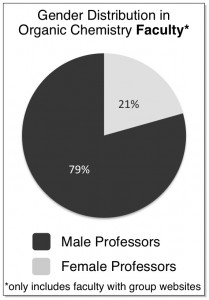 total of 23 female professors and 98 male professors (19% female). This is very close to the gender distribution among all chemistry faculty reported by C&EN (they report 17% female). Since research group websites were my only source of information about group demographics, I could only include faculty that actually have such a webpage when making comparisons between faculty and student gender distribution. This eliminated 4 female professors and 25 male professors, which brought the percentage of female faculty up slightly, to 21% (figure on the right). However, this increase seems reasonably fair, since it appears that several of the male professors eliminated from the count (but none of the female professors) are currently inactive (no longer taking students/postdocs).
total of 23 female professors and 98 male professors (19% female). This is very close to the gender distribution among all chemistry faculty reported by C&EN (they report 17% female). Since research group websites were my only source of information about group demographics, I could only include faculty that actually have such a webpage when making comparisons between faculty and student gender distribution. This eliminated 4 female professors and 25 male professors, which brought the percentage of female faculty up slightly, to 21% (figure on the right). However, this increase seems reasonably fair, since it appears that several of the male professors eliminated from the count (but none of the female professors) are currently inactive (no longer taking students/postdocs).
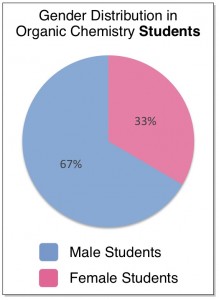 Students. The headcount of students in these labs yielded 492 women and 980 men, for a total of 33% female students. This is somewhat lower than the 39% female doctoral students reported by C&EN, which may be a reflection of my biased sample set (top 10 universities) and/or the fact that I am including post-docs and undergraduate researchers in my numbers. Alternatively, it could be that a smaller percentage of women pursue an organic chemistry education than an education in one of the other disciplines of chemistry.
Students. The headcount of students in these labs yielded 492 women and 980 men, for a total of 33% female students. This is somewhat lower than the 39% female doctoral students reported by C&EN, which may be a reflection of my biased sample set (top 10 universities) and/or the fact that I am including post-docs and undergraduate researchers in my numbers. Alternatively, it could be that a smaller percentage of women pursue an organic chemistry education than an education in one of the other disciplines of chemistry.
Lab Size. On average, the labs of the female faculty members seem to be smaller than those run by male faculty members. Of the 1472 total students counted, 1215 of these were distributed among the labs of the 73 male faculty members, leaving 257 students in the labs of the 19 female faculty. This averages out to 13.5 students per female PI and 16.6 students per male PI.
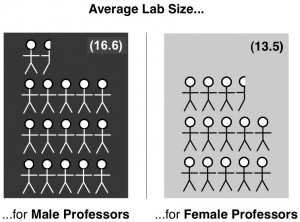
Lab Demographics. Interestingly, the labs of male and female professors do seem to have different gender demographics. Whereas labs run by male professors are about 32% female, the labs run by female professors are composed of about 41% female students.
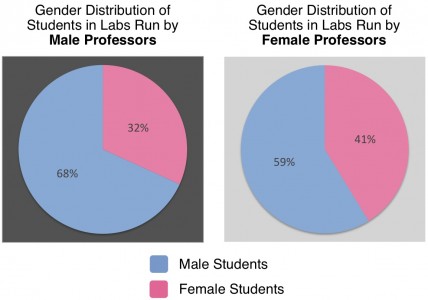
This discrepancy indicates a somewhat disproportionate tendency for female students to work with female professors. If the data are broken down a different way, this trend still seems apparent: Since only 257 of the total 1472 students are working in labs run by a female professor (see above), we can say that 17% of the student positions “available” are with a female PI. Thus, a statistical distribution of genders across labs would mean that 17% of the total female students and 17% of the total male students work for a female PI. However, this is not the case. 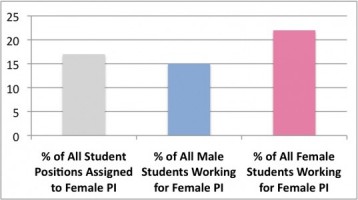 Of the 980 male students, 151 (15%) work for a female PI, while 106 of the 492 female students (22%) work for a female PI. These percentages suggest only a slight disinclination for men to work with a female PI, and a more noticeable inclination for women to work with a female PI.
Of the 980 male students, 151 (15%) work for a female PI, while 106 of the 492 female students (22%) work for a female PI. These percentages suggest only a slight disinclination for men to work with a female PI, and a more noticeable inclination for women to work with a female PI.
Discussion
The reasons behind the dearth of female faculty members in chemistry is the subject of some debate. Some argue a “critical mass” hypothesis – that unique concerns of women tend to be marginalized until enough women are present to have a sufficiently strong voice. Thus, workplaces with few women may feel less welcoming to prospective female employees, and so a vicious cycle persists.
Another take on the issue is the idea of stereotype threat. This psychology theory posits that groups who perceive a negative stereotype against them have a tendency to underperform, perhaps due to increased anxiety that they will perpetuate the stereotype. This phenomenon has been observed by various psychologists (see this recent book review in Science). Since different individuals perceive and respond to stereotypes differently, some women may be more “immune” to stereotype threat than others. These may be the women blazing the way for others – those first few female faculty members. The observed disproportionate number of female students working with a female faculty member could be due to reduced stereotype threat for women in a setting where they have a successful female role model. Women may feel more able to perform to their full potential in such an environment where they perceive greater confidence in their gender.
Final Note
Personally, I have been fortunate to be raised in an educational environment that never even hinted to me that “girls aren’t as good at science”. As a result, the idea of a gender stereotype feels a little foreign, and I hope that feeling reflects a growing trend in education. The professor I work for happens to be a woman. Although I didn’t choose to work with her because she’s female, I do feel that her dramatic success in the face of clearly negative odds is an encouragement to me and the other women in my lab.


As an aside, it is interesting to note that in 2009, the U.S. population was composed of 156,006,721 females and 119,597,914 males. Clearly, women are the majority group. Yet the National Science Foundation lumps women together with minorities and the disabled for tracking in its trend studies. As another aside, since women are typically forced to choose between career and family, I wonder what the stats look like in schools where there have been deliberate efforts to provide a more family-friendly environment (such as quality, accessible, on-site child care).